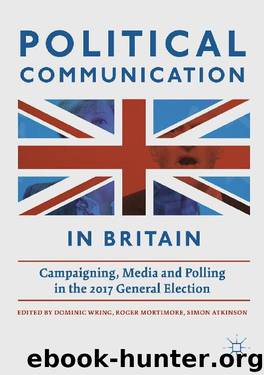Political Communication in Britain by Unknown

Author:Unknown
Language: eng
Format: epub
ISBN: 9783030008222
Publisher: Springer International Publishing
Published: 2018-11-24T00:00:00+00:00
Conclusions
The Conservative Party’s primary mistake was to risk its majority by calling a snap election in 2017. In the post-Brexit context, the party and its leader would have offered the UK greater strength, stability and leadership by seeking to maintain some sense of continuity until the Brexit negotiations had concluded. If this was the first error, the party’s second mistake was to retain the kind of presidential model of campaigning so central to the party’s 2010 and 2015 election strategies under David Cameron (Langer 2011). Theresa May’s comparatively unknown and underdeveloped campaign skills were misjudged by key party strategists. Temporary popularity was mistaken for the ability to connect with the UK electorate, resulting in an incongruous campaign emphasis on the party leader . CCHQ’s apparent contempt for party volunteers and its lack of relationship building strategies seemingly contributed to a decline in wider party engagement. This is counterproductive when competing with growing citizen-initiated campaigning in other parties (Gibson 2015).
The digital age and its communication technologies are well suited to a decentralised model of political campaign engagement that shares authority within a more party-focused campaign. Ironically, it was Jeremy Corbyn and Momentum that brought this to the attention of the Conservatives. Momentum’s 2017 digital activity has catalysed a Tory rethink about how the party’s organization can compete with such phenomena in the digital age. In the post-Brexit context, such discussions still remain relatively low down as priorities on the party’s agenda. Sun Tzu’s ‘Art of War’ famously advises never to underestimate your opponent. If the Conservatives’ unpreparedness in terms of policies, presentation and communication of message is anything to go by, it seems the party underestimated its opponent in Jeremy Corbyn while overestimating Theresa May’s strength as a leader (Ridge-Newman 2017). This was particularly embarrassing given the snap election was designed to exploit a considerable strategic advantage in terms of its timing and the element of surprise in calling it. Yet the initiative was lost when the plan backfired. It proved to be the party’s third major error.
The Conservatives, and other parties behind the curve, would benefit from developing a deeper understanding of the fast-evolving political communication environment and hybrid media system in which they now operate (Chadwick 2017). Highly controlled and centralized campaigns like Theresa May’s awkward and analogue performance in 2017 can create an anachronistic atmosphere, which discourages democratic interactivity on- and off- line, thereby undermining public credibility and trust (Seiler and Kucza 2017). The Conservative Party seems out of sync with recent technocultural trends that require the party to trust and empower its own increasingly disenfranchised membership and redevelop the type of campaign engagement environment that developed naturally at its grassroots in 2010 (Ridge-Newman 2014). Campaigns are likely to become increasingly real-time and digital: and fluid campaign strategies that embrace interactivity and relationship building will likely be increasingly significant to campaign successes in future general elections.
Download
This site does not store any files on its server. We only index and link to content provided by other sites. Please contact the content providers to delete copyright contents if any and email us, we'll remove relevant links or contents immediately.
Things Are What You Make of Them: Life Advice for Creatives by Adam J. Kurtz(1834)
The Monuments Men by Robert M. Edsel(1757)
The Freelance Manifesto: A Field Guide for the Modern Motion Designer by Joey Korenman(1602)
Find Your Artistic Voice by Lisa Congdon(1407)
The Business of Being an Artist by Daniel Grant(1353)
101 Gag Ideas: Companion to the One Minute Caricature by James van der Keyl(1337)
Boom by Michael Shnayerson(1311)
Your Art Will Save Your Life by Beth Pickens(1262)
Your Inner Critic Is a Big Jerk by Danielle Krysa(1255)
Breakfast at Sotheby's(1209)
The Lady in Gold by Anne-marie O'connor(1205)
Seven Days in the Art World by Sarah Thornton(1196)
Create Your Art Career by Rhonda Schaller(1187)
How to Survive and Prosper as an Artist by Caroll Michels(1175)
Need you Now (Top Shelf Romance Book 2) by unknow(1146)
33 Artists in 3 Acts by Sarah Thornton(1123)
When Talent Isn't Enough: Business Basics for the Creatively Inclined by Kristen Fischer(1122)
Art of the Deal by Noah Horowitz(1080)
Art Held Hostage by John Anderson(1079)
